1968 French Grand Prix race report: Ickx glides to victory
Ferrari’s Jackie Ickx takes his debut victory in treacherous conditions; Jo Schlesser tragically killed in new magnesium lined Honda
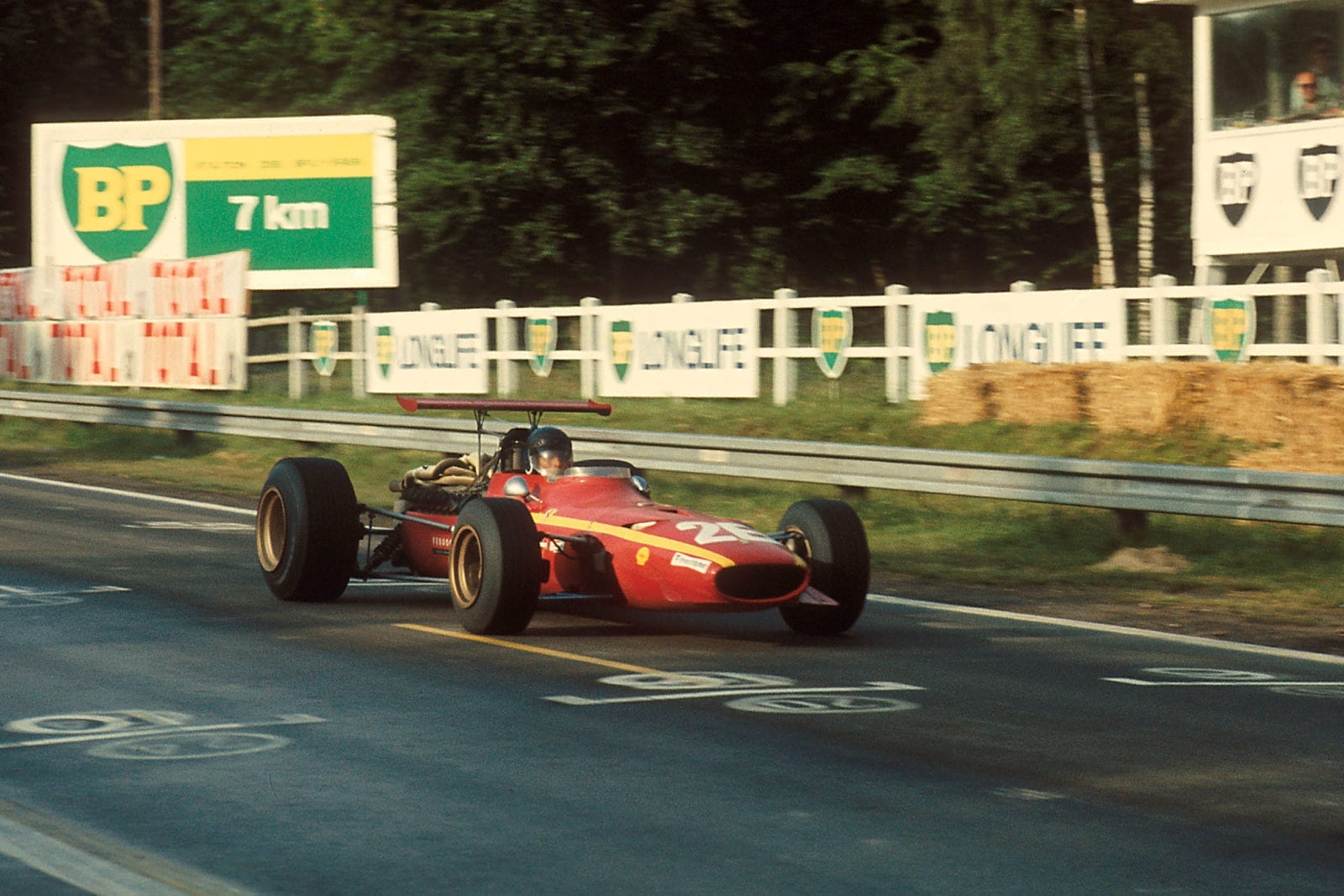
Jacky Ickx took his first F1 victory in France
Motorsport Images
After the upheaval in French motoring circles last winter, when the FFSA took control of the sport from the ACF, a statement was issued that there would not be a further Grand Prix de l’ACF, which many people took to mean that there would be no French Grand Prix, but later the FFSA put out a notice that they would be running the first Grand Prix de France.
So 1968 saw the end of the oldest Grand Prix race in history, the GP de l’ACF, and the start of the youngest, the Grand Prix of France. For those not interested in definitions and organisations all this was of little importance, for the previous races have always been referred to as the French Grand Prix, and the new title is translated into English with the same words. It is really a case of a change of government and title, but the established event remains the same.
The circuit at les-Essarts, some miles south of Rouen on the way to Elbeuf, is in thick forest land and is one of the better European road-racing circuits, being very fast, interesting, spectacular and exciting to drive round, let alone race round, but there is a price to pay and that is the limitation on the amount of time for which the roads can be closed for racing.
There is never any practice on Saturday at les-Essarts, so that Grand Prix practice was held on Thursday and Friday in the late afternoon. The first session was supposed to have been from 5:30pm to 6:30pm, almost criminally short for a major Grand Prix, but, to make matters worse, it started at 5:20pm and was all over by 6:10pm, leaving everyone very disgruntled, the more so as the circuit was used until it was almost dark, by Formula Three contestants and a National “boy-racer” Formula entry.
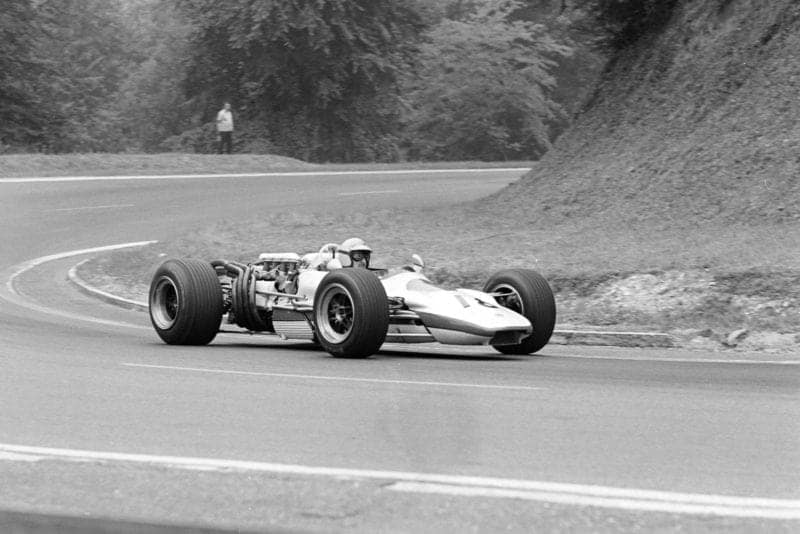
Schlesser was driving the new Honda
Motorsport Images
This was the first time 3-litre Grand Prix cars had been on the circuit, and the existing lap record was held by Rindt with a 1,600cc F2 Brabham at 2min 02.6sec for the 6.542-kilometre circuit (approximately 120mph), so any self-respecting Grand Prix driver expected to break the 2-minute barrier and the faster cars would obviously be averaging over 125mph, which is a healthy speed on a circuit containing two hairpin bends.
As the cars assembled for practice chief interest centred around the appearance of a brand new Honda from Japan, as distinct from the Honda from Slough. This was the V8-cylinder car, with air-cooling and numerous different approaches to Grand Prix car design, and is described in detail elsewhere.
There was a certain amount of umbrage in the paddock as Surtees had tried the car at Silverstone, pronounced it not ready to race and intended to put into motion one of his well-known “development and testing programmes”, which tend to go on a bit, saying he would continue to race the V12 water-cooled Honda in the meantime.
On the morning of practice Mr Honda took the new car and gave it to Schlesser to drive, on behalf of Honda-France, who were in the throes of trying to overcome embargoes on the import of Honda mini-cars into France; Mr. Honda had made a personal appearance in Paris at the beginning of the week, to assist his business enterprise, and entering his latest Grand Prix creation in the French GP with a French driver was obviously calculated to jolly things along in circles above motor racing.
As there was no sign of Gurney and his Eagle, the progress of Anglo-American Racers being rather unsteady since they left Weslake Engineering, the Honda-France entry took the programme number of the Eagle, which confused a number of onlookers! While this new car was being run experimentally, the entry of a Grand Prix Alpine-Renault did not materialise, though the car was out on test in Belgium, on the Zolder circuit, it being powered by the 3-litre V8 Gordini engine as used in the Le Mans Alpines.
A full entry of regular Grand Prix contestants appeared, Brabham and Rindt driving the 4-ohc Repco-powered Brabham cars, with the BT24 model as a spare; Beltoise driving the latest of the two V12 Matras, incorporating numerous parts made in titanium, a repositioned oil tank, and strange aluminium fairings over the top front suspension rocker arms, said to deflect the air and exert a downward force; Hulme and McLaren driving the M7A McLaren cars, both carrying aerofoil stabilisers above the engine, like the Ferraris, and mounted directly on the engine; Hill and Oliver in the works Lotus 49B cars, 49/5 repaired after its minor accident at Zandvoort, and 49/6 having much wider nose fins, while both cars carried really big aerofoils across the rear of the car, these being mounted directly on the hub carriers as the Chaparral did last year.
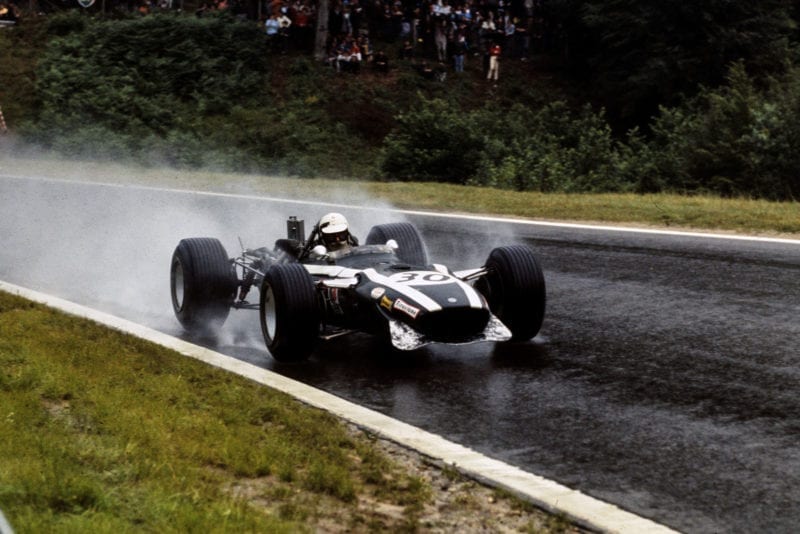
The Cooper team brought their new T86B car, seen here driven by Elford
Motorsport Images
Surtees was busily getting on with the V12 Honda, the RA 301 model, now fitted with lower and slightly tidier exhaust pipes, and Schlesser was driving the aforementioned RA302 Honda V8; Rodriguez and Attwood with the works BRM V12 cars had new nose cowlings, in which the hot air from the radiator escaped upwards through large apertures on the top surface of the cowling, in the fashion of the McLaren cars, and they had a third car as spare.
Amon and Ickx were driving the works Ferraris, the former having two cars to choose from, the latter only one, these being the same three cars as used at Zandvoort; they were fitted with two small scoops on the crash bar which directed air on to the central exhaust manifold; Stewart was driving the Ken Tyrrell Matra-Cosworth V8 with which he won in Holland, it having the aluminium deflectors on the front top rocker arms as on the V12 Matra.
The Cooper team had a brand new Type 86B with BRM V12 engine, driven by Elford making his Grand Prix debut, and the original Type 86B driven by Servoz-Gavin on temporary loan from Matra, and Siffert in the Rob Walker Lotus 49 and Courage in Parnell’s Type P126 BRM V12 completed the entry.
Qualifying
Being the lap record-holder and having won the Formula Two race on the circuit last year, Rindt shot off the moment practice began and set a searing pace in the Brabham-Repco, getting well under 2 min. for the lap almost immediately, his 4-camshaft Repco V8 working well for a change. Surtees was not too happy with the way Honda had managed things over the matter of the new V8 and he showed that the V12 was very race-worthy by thrashing round for a number of laps and being second fastest for quite a time, lapping under the 2min mark.
The enormous aerofoils on the Lotus works cars made the Ferraris, McLarens and Brabhams look a bit ineffective with their mini-wings, and with these in place the Lotus wedge tails were not fitted. However, they were not happy, for the right-hand drive-shaft on Oliver’s car was overheating its outer universal joint, and Hill was only just on the bogey-time of 2min.
Elford had a bad start to his first Grand Prix, for the fuel pump on the rear of the Hewland gearbox seized and broke its drive before he had started to try and go fast. Brabham was also in fuel system trouble and his 4-cam Repco V8 was running very badly, but Rindt was making up for this by staying at the head of the list and going faster and faster, ending with a time of 1min 56.1sec, a speed of 202.852kph (approximately 126mph).
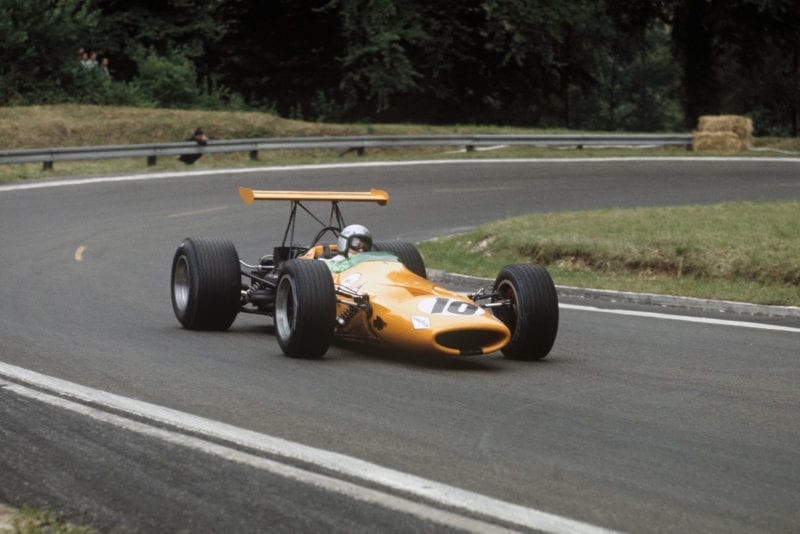
Bruce McLaren and his team were pleased with the changes made to their cars
Motorsport Images
The two McLaren drivers were well satisfied with their cars, considerable improvements having been made to the handling since the last race, and the aerofoils were giving them confidence so that they were both well under 2min for a lap, and Amon and Ickx were equally happy with the Ferraris, making almost identical times and half a second quicker than the McLarens.
“Stewart also broke the 2min barrier, still driving with his wrist strapped up”
Stewart also broke the 2min barrier, still driving with his wrist strapped up, and Rodriguez got below bogey-time, but Attwood just missed it. The V8 Honda seemed trouble-free mechanically, but Schlesser was having to feel his way along carefully, never having driven anything with quite so much potential, and while learning he spun the car, but was quite happy.
Although eight drivers got below the 2min mark none of them could approach Rindt’s time in the short period of practice and when they all had to pack up and go home and leave a horde of amateur Formula Three drivers on the circuit they were justifiably disgruntled.
On Friday, practice was vaguely from 5pm to 6pm, but in a feeble attempt to make up for the previous evening, it was extended for some 20 minutes. Fortunately both evenings were fine and dry, if somewhat overcast and dull, but the second session did not go off in such a rousing fashion.
Rindt could not repeat his previous performance, his Repco engine playing up and being difficult to start, and at one point the Brabham people were pouring petrol into the intakes from a bottle when there was a back-fire and a great sheet of flame that was more impressive than dangerous, but it made everyone leap in the air very smartly and be more careful.
Hill was having trouble with the gearchange of his Lotus fouling something, and Oliver had a monumental accident when he got on the grass shortly before the pits and struck a parapet which tore the entire gearbox and rear suspension right off the car; he was very lucky to step out of the monocoque unscathed, but the car was beyond immediate repair.
The V12 Matra appeared with a sheet of aluminium, forming an air deflector, over the rear of the engine, and it also had extra fuel tanks attached to the cockpit sides, on the outside. Elford was still in trouble, for after getting down to competitive times there was a loud bang and a big hole in the bottom of the BRM engine in his Cooper, and Servoz-Gavin’s engine in the other Cooper would not run properly, later traced to the valve timing having got out of phase.
Although Stewart improved on his previous best time, he could not approach Rindt’s fastest, while the time that lckx did on Thursday put him in third place in the front row, even though Hulme had equalled it on Friday. Beltoise and Hill joined the select “under-2 min” group, so that there were ten very competitive entries for the 60-lap French Grand Prix.
Race
***
The whole of Saturday was available for preparing the cars for the race, and there was a final test session at 8am on the Sunday morning for those who wanted to take advantage of it. The race itself was not due to start until 4pm, the whole of the day being taken up by two National races, a Formula Three race and lunch.
This Festival of Speed, rather like a Silverstone meeting, was unfortunate, for the weather forecasts predicted rain before the end of the afternoon, and the skies were ominous all morning.
Before the cars came out on to the grid there was a grand parade of a lap by some 20 Matra 530 rear-engined coupés, with the detachable tops removed, and in each one was a Grand Prix driver in the passenger seat, and his entrant, team manager or some other team member at the wheel.
Tyrrell drove Stewart around, Forghieri drove lckx, Le Guellec drove Beltoise, Rob Walker drove Siffert, and so on. While all this was going on there was a panic in the Brabham camp with a fuel tank leak on Rindt’s car, and at Coopers one of the flexible rubber bag tanks in one of their cars had sprung a leak.
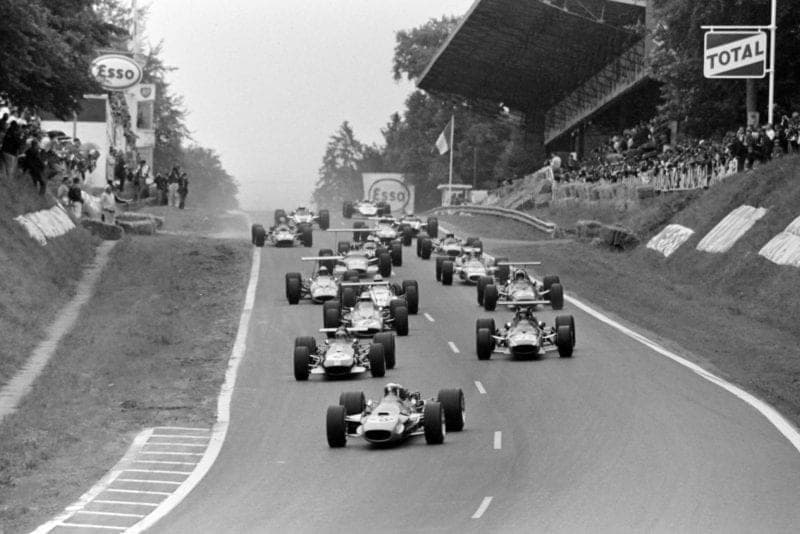
Stewart takes first place at the start
Motorsport Images
With a race distance of 392 kilometres some cars were near the limit on fuel capacity and on McLaren’s car a 2½-gallon cylindrical tank had been mounted on the rear, alongside the cylindrical oil tank, while Hulme’s car had a slightly larger capacity slab tank strapped to the right side of the cockpit.
The V12 Matra was still carrying its side tanks, and Courage’s BRM had the side tank strapped on as in Holland. Amon was using the newer of his two Ferraris, 0011, even though the engine was not as sharp as it should have been, for there had not been time in the short practice periods to get 0007 set-up for the circuit. Oliver was a non-starter, there being no spare works Lotus; Rodriguez was driving P133-01 and Attwood P126-03 and everyone else had the cars with which they practised.
“In one of the most untidy starts ever seen, due entirely to bad marshalling and flag control, 16 cars got away in a ragged column”
After one warm-up lap, with the time already well past 4pm, the 17 cars lined up on the dummy-grid and there was feverish activity on Siffert’s Lotus, changing the battery, and this was still going on when the field moved forward to the main grid. As they did so, some 15 minutes late a gentle rain was falling and there was obviously more to come.
In one of the most untidy starts ever seen, due entirely to bad marshalling and flag control, 16 cars got away in a ragged column, leaving Siffert on the dummy-grid. He finally got going long after everyone else had disappeared down the fast, winding descent to Nouveau Monde.
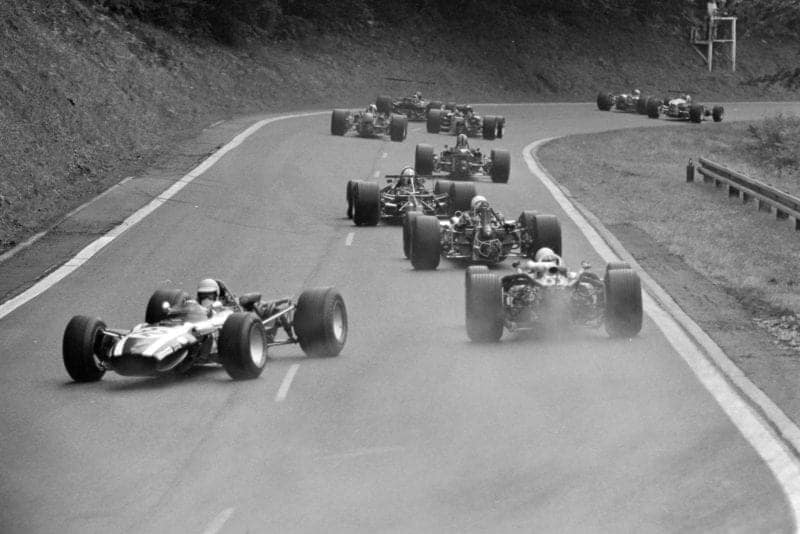
Servoz-Gavin spins in front of the rest of the field
Motorsport Images
It was Stewart’s Matra-Cosworth which led down to the hairpin, keeping up the Matra score of leading every Grand Prix race this year, but on the back of the circuit Ickx swept by into the lead on the wet track.
With the uncertainty of the weather just before the start there was a lot of dithering-about over which tyres to use and in the end Ickx was the only one on full rain tyres and now that the rain was coming down he was making the most of it.
Going up the hill from Nouveau Monde, through the sharp left-hand Sanson Corner, Servoz-Gavin spun his Cooper and there was some quick dodging by the followers. This dropped him to the end of the field, save for Siffert, who nearly caught the Cooper while it was losing time. All 17 streamed through at the end of the opening lap, led comfortably by Ickx, with Stewart, Rindt, Surtees, Rodriguez, McLaren, Hill, Beltoise, Amon, Hulme following in quick succession, the rest tailing away until Servoz-Gavin and Siffert brought up the rear.
On the second lap there was some sorting out and Rindt got past Stewart in second place, Hill got past McLaren, Amon passed Beltoise and Courage passed Elford, and down the wet streaming hill they all went, to the tight Nouveau Monde hairpin again.
“Alas, poor Schlesser never made it, for he lost control of the Honda V8 on the fast right-hand bend near the bottom of the hill”
Alas, poor Schlesser never made it, for he lost control of the Honda V8 on the fast right-hand bend near the bottom of the hill and slid off the road on the outside and went up the bank. The car overturned and caught fire, the burst petrol tank throwing burning petrol on to a number of spectators, luckily without serious consequence. Schlesser was killed in the holocaust of burning petrol and magnesium and the fire spread right across the track. Servoz-Gavin and Siffert who were following just managing to squeeze by as flames and black smoke curled up into the already gloomy sky.
As the leaders finished their third lap they knew little of the tragedy, but as they went down the hill it became all too clear.
During the third lap both Surtees and Rodriguez had gone past Stewart and Rindt, but they were three seconds behind Ickx, and when they got to the scene of the accident they all had to slow down and pick their way through the debris.
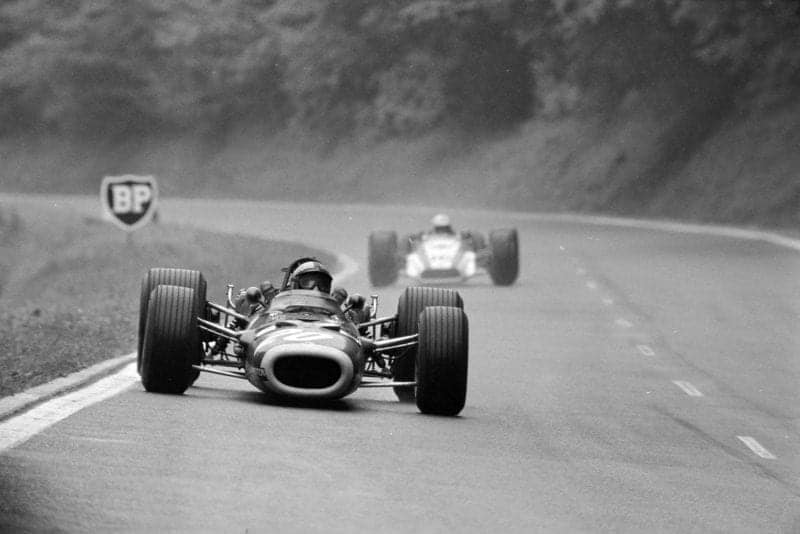
Rodriguez and Surtees (pictured in background) moved into the top two positions on lap 3
Motorsport Images
In doing this Rindt picked up a piece of metal in his left rear tyre and it deflated so that he had to do the rest of the lap slowly and stop at the pits. However, while he was driving slowly along his team leader, Brabham, went by with a badly running engine and went into the pits at the end of lap 4, and Rindt arrived a little later.
The left rear tyre was taken off Brabham’s car and put on Rindt’s and the Austrian was back in the race, but too far back to ever see the leaders again. Brabham’s trouble was still in the fuel pump and fuel system and he stayed at the pits for a long time.
With ambulances on the circuit and firemen and marshals at the scene of the accident, everyone had to reduce speed, and Surtees and Rodriguez closed up on Ickx, the three of them staying nose to tail on lap 5.
The accident had obviously upset Beltoise and he dropped back to the end of the main pack, Siffert being a long way back, driving unhappily without a clutch, and Rindt was over a lap behind. The pace was relatively slow at 2min 14sec a lap, but even so the average speed was over 108mph.
Once the effects of the accident were over Ickx began to pull away again, and on lap 7 Rodriguez went past Surtees and stayed in front of him, but could not get away. One of the BRM’s rear tyres picked up a hard object as they passed the crashed Honda V8 and flung it at Surtees, striking his goggles and dislodging a lens, which did not make his job any easier, so he was content to keep the BRM in view.
At ten laps, which had seemed to take an age to cover, Ickx had nearly seven seconds’ lead over Rodriguez, who had Surtees just behind. After a gap came Stewart, then Hill after a similar gap, and then a long way back came McLaren. Not far behind him, Courage was leading Elford, Attwood, Amon, Hulme and Servoz-Gavin, all in quick succession, but Amon and Hulme were making no attempt to motor-race, being dry-weather drivers.
“One of the BRM’s rear tyres picked up a hard object flung it at Surtees, striking his goggles and dislodging a lens”
Beltoise had already been lapped by Ickx and on lap 11 he stopped at the pits and had wet-weather tyres put on the Matra to see if it would give him any confidence to go quicker, but it did not make much difference, and he was now last and behind Rindt.
At this point Brabham got his car going again, and did one lap to see if it was any better, but it wasn’t. Hill had been striving to catch Stewart, which he did on lap 13, and Courage was going well, leaving Elford and Attwood behind and catching McLaren, going by into sixth place on lap 14.
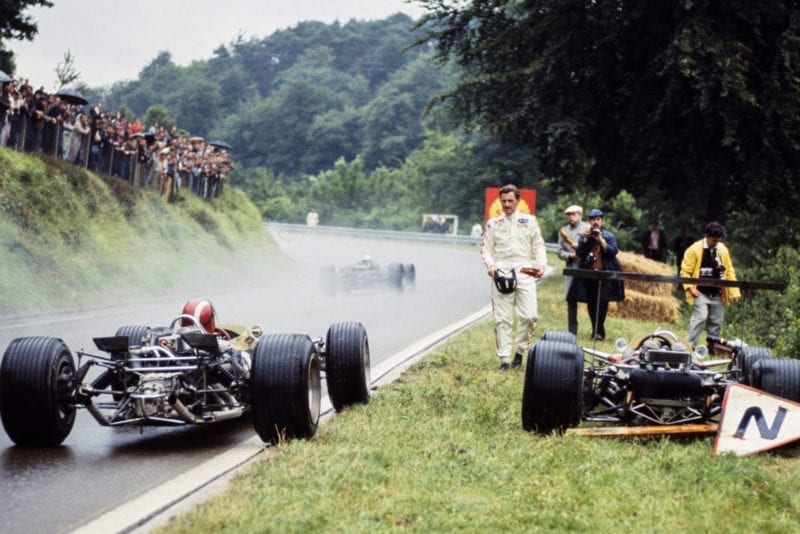
Hill retired and then generously gave Siffert (seen pulling over) his visor
Motorsport Images
Hill’s joy at passing Stewart was shortlived, for as the Lotus accelerated up the rise from Nouveau Monde the left-hand drive-shaft broke and Hill coasted on to the grass to stand in the rain and watch the others go by.
A little further on another driver was to stand in the rain and ponder, for Servoz-Gavin spun off and crashed into the woods with his Cooper-BRM, luckily escaping any injury, but they both got very wet as they made their way back to the pits.
Ickx was gradually lapping everyone, his driving in the wet being the complete opposite to his performance at Zandvoort and having a lot to do with his liking for the Rouen-les-Essarts circuit, for a happy and contented driver will always go faster, no matter what the conditions.
Surtees was still pressing hard on Rodriguez and these three had left Stewart far behind. Amon and Hulme were lapped by Ickx, which must have made them wonder if they were really Grand Prix drivers, and then he lapped Attwood and Elford, the latter doing well in his first race, but conscious of the fact that he was only on the bottom rung of a very long ladder.
As the leaders were on lap 19, really torrential rain came down, squalling across the circuit, and Rodriguez and Surtees slipped by into first and second places, holding these positions as they finished the lap, and this little effort gave Rodriguez the fastest lap of the race in 2min 11.5sec, but Surtees could only have been a fraction slower.
Down the hill Ickx recovered traction and went back into the lead while the heavy rain continued, and at the pits there was a lot of activity, for Hulme had stopped with a punctured left-front tyre, and while it was being changed the storm had reached the pits, so he had all four changed for rain tyres.
“The Ferrari got into a vicious snaking motion which made one realise just how close to the limit of adhesion these chaps were”
In the downpour Attwood and Amon also stopped to change all their tyres, and at the end of lap 20 McLaren did likewise. None of these drivers were going to win the race, or even looked like figuring prominently in the results, so they had nothing to lose, but it made them feel better.
As Ickx came down the pits straight to finish his 21st lap the Ferrari got into a vicious snaking motion as he crossed the white-painted lines of the dummy-grid, which made one realise just how close to the limit of adhesion these chaps were.
Stewart threw away his fourth place by stopping at the end of this lap and changing to wet-weather tyres, and this let Courage up into fourth place, which was well deserved, for the young BRM driver was driving very competently, but he was lapped by the irrepressible Ickx on the next lap, so that only Rodriguez and Surtees were on the same lap as the leader, but they were no longer any worry to Ickx.
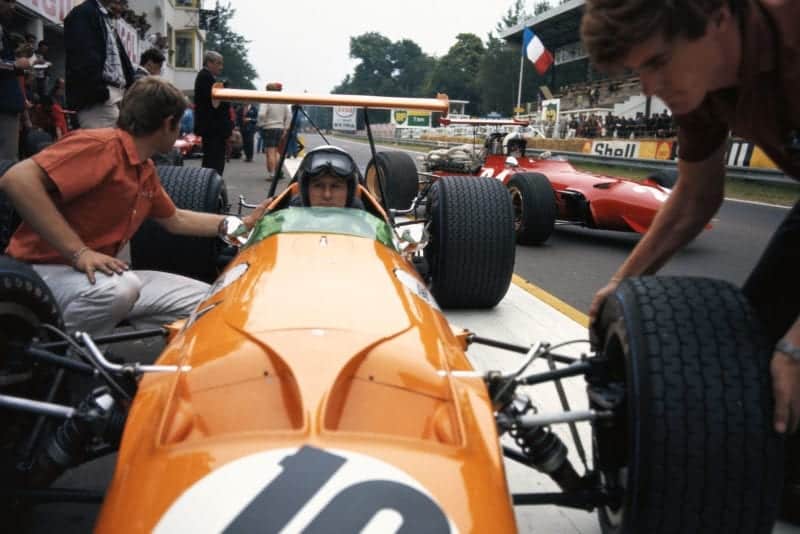
McLaren stops for a tyre change
Motorsport Images
On lap 25 Courage could feel something trailing under the cockpit and, fearing that it might be a vital oil-pipe or water-pipe, he slowed down, letting Stewart go by, and stopped at the pits. It was one of the supporting straps for the side tank, which is fixed to the seat-harness bolts, and was not vital, for the tank was held by two more, but, having stopped, it was repaired.
As the rain was still coming down steadily, Parnell decided that the car might as well have a set of wet-weather tyres fitted, so this was done, but by the time Courage rejoined the race he had dropped from fourth place to twelfth, which was a pity, for he had earned his fourth place.
By the time half-distance arrived, which was 30 laps, everything had settled down and everyone was wet and miserable except the Ferrari team and Ickx. He was leading Rodriguez by a comfortable 7.5sec, who was in turn 3.7sec ahead of Surtees in third place.
Stewart, McLaren and Elford were all one lap behind, and Rindt, Hulme and Attwood were two laps behind, while three laps behind were Amon, Siffert, Courage and Beltoise.
However, at this point McLaren got a puncture in his right-rear tyre and stopped at the pits, which dropped him down to next to last, and Courage was making up time for his pit stop and was about to catch Siffert.
The race average was just on 100mph (160.909kph), which was 20mph under what it would have been in the dry, but still very fast for the awful weather conditions. Brabham had done one more lap and was still fiddling about trying to make things work properly, and Surtees was getting tired of squinting through his damaged goggles and on lap 34 he made a quick pit stop to grab another pair.
It did not lose him a place, but it lost him all contact with Rodriguez, so that everything settled down now to a wet routine of ticking off the laps. For a brief moment the rain stopped and the sun actually shone through the clouds, and Brabham went off once again, this time to do seven laps before he stopped.
Ickx went on and on faultlessly, and at the end of lap 41 he was right behind Surtees, passing him on the next lap, to put the Honda a whole lap behind the Ferrari, and meanwhile he was over 2min ahead of second placeman Rodriguez.
Way down the field Courage was not giving up after his long pit stop and had caught Attwood in the second works BRM, passing him on lap 44. When Rindt and Amon arrived at the end of their 44th lap, by which time the leader was on his 47th lap, they both stopped at the pits, Rindt to retire, as a petrol tank was leaking and he was soaked in petrol as well as water, and Amon to set off again after losing a place to Beltoise.
On lap 46 BRM fortunes tumbled, for Rodriguez had his Hewland gearbox stick in second gear and as he slowed the leading Ferrari lapped him, and by the time he got to the pits Surtees had also passed him and taken second place, though still a lap down on the Ferrari.
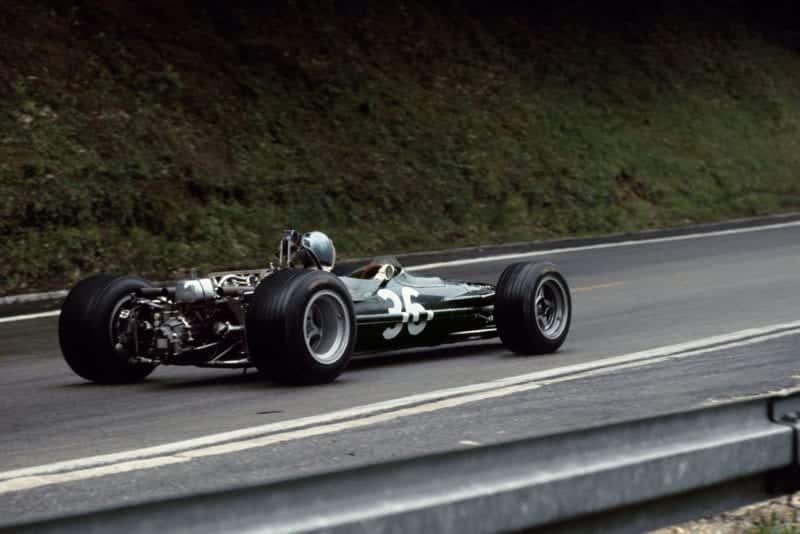
Courage brought his Reg Parnell BRM home in 6th
Motorsport Images
While the gear mechanism was looked at it was seen that the right-rear tyre was deflating and a petrol pipe was damaged, so the stop was a long one, and Stewart moved up into third place. The gearchange fault could not be located, so the gearbox was put into fourth gear and the Mexican was told to leave it there and do the best he could to keep going to the finish.
All this meant that Ickx had no worries and he eased off, letting the Honda go by and unlap itself, and as long as he kept it in sight he could tour home to win. After two laps Rodriguez was back in the pits, the gearbox somehow having got itself stuck in second gear again, and this stop let Elford move up into fourth place.
With ten laps left to run the sun came out again and Ickx was now coasting along, not even bothering to keep up with the Honda. One lap behind was Stewart, no doubt wondering what had happened to all his Zandvoort supremacy, and two laps behind Elford was running very steadily and fast for a beginner, leading Hulme and Rodriguez, the BRM once again fixed in fourth gear.
Then came Courage, who really should have been in Elford’s position, followed by Attwood, who was making people realise that Monaco had been viewed through rose-coloured spectacles, and McLaren, Beltoise, Amon and Siffert were tailing dejectedly along in the rear.
“Ickx was acclaimed enthusiastically as he received the chequered flag at the end of the 60 laps, having averaged just over 100mph on his non-stop drive in appalling conditions”
On lap 51 Rodriguez stopped again, this time claiming that the gearbox had selected second gear of its own accord, and once more he rejoined the race to continue slowly, but now in last place.
As the race was coming to a close Brabham suddenly came to life and did three more laps! Having led the whole race with the exception of the first half-lap, and for a brief moment on lap 19, Ickx was acclaimed enthusiastically as he received the chequered flag at the end of the 60 laps, having averaged just over 100mph on his non-stop drive in appalling conditions. He more than made up for his poor showing at Zandvoort, and put renewed faith into Firestone, whose tyres he was using.
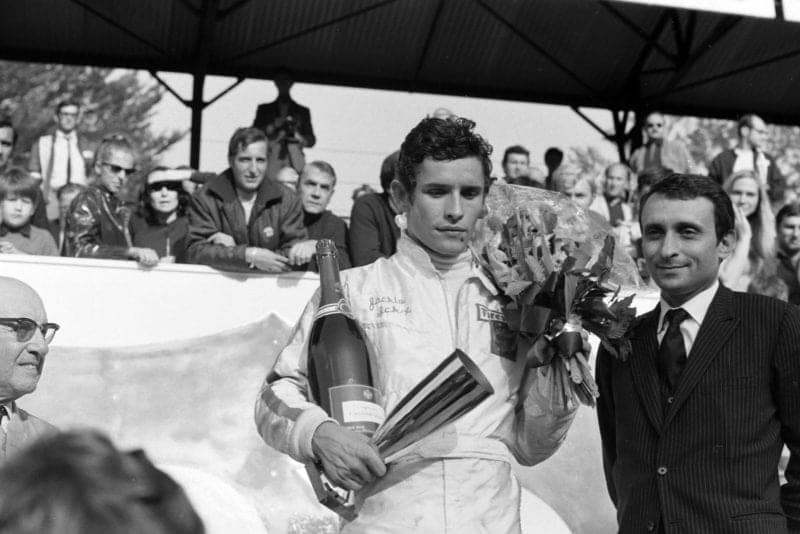
Ickx receives the plaudits
Motorsport Images
A Ferrari victory has been overdue and its likelihood was seen earlier in Spain, but a lot of people expected Amon to achieve it. Surtees arrived second, the V12 Honda having run well, and Stewart was third, rather unhappy, for had it been dry he would undoubtedly have been in the running for another victory.
In a very worthy fourth place was Elford in the Cooper-BRM in his first Grand Prix race, having driven non-stop and given a perfect exhibition of what a new boy should do. Hulme was fifth, with Elford actually in sight at the end, but the New Zealander is a fair weather creature and was not seriously motor racing.
It was not a good French Grand Prix, whether you look upon it as another one in the long history of French motor racing or the first of a new era. It was a sad and wet event.—D. S. J.
———
Rouen Ramblings
- The race upset the form book. After the wet Dutch GP many people thought Dunlop were supreme in rain. I thought Matras were good on wet roads, and Ickx seemed hopeless, while Stewart was brilliant. Could it be that anyone can go fast on the easy, safe Zandvoort circuit, but skill and bravery are called for on the spectacular circuit of les-Essarts?
- Elford was driving a brand new Cooper-BRM V12, number F1-4-68, the third car of the 1968 series not yet being seen as it was altered to take the V8 Alfa Romeo engine.
- This was the first race under the aegis of the FFSA, although the AC of Normandy did the organising. They earned a lot of black marks, for minimal practice time, too much time spent on unimportant races, a late start and a shambles of a starting grid, while the Press Service was almost non-existent. The programme contained some awful mistakes, which did not help.
- Ferrari were delighted with their victory, as were Firestone, but Dunlop and Matra were puzzled and Goodyear were very sad. Rindt, Hulme. McLaren and Rodriguez all got punctures in their Goodyear tyres from running over bits of the debris from the accident.
